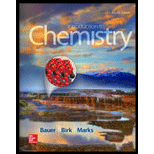
Concept explainers
(a)
Interpretation:
The calculation of the number of moles and volume of
(a)
Explanation of Solution
Where, R is the universal gas constant and its values changes in accordance with the units of pressure, volume and temperature.
The given mass of
For
The number of moles of gases is calculated using the given formula:
Here,
Substitute
Recall equation (1),
Substitute
(b)
Interpretation:
The calculation of the number of moles and volume of
(b)
Explanation of Solution
The conversion factor of temperature from Celsius to Kelvin is as follows:
For
The number of moles of gases is calculated using the given formula:
Here,
Substitute
Recall equation (1)
Substitute
(c)
Interpretation:
The calculation of the number of moles and volume of
(c)
Explanation of Solution
The conversion factor of temperature from Celsius to Kelvin is as follows:
For
The number of moles of gases is calculated using the given formula:
Here,
Substitute
Recall equation (1),
Substitute
Want to see more full solutions like this?
Chapter 9 Solutions
Introduction to Chemistry
- Raoul Pictet, the Swiss physicist who first liquefied oxygen, attempted to liquefy hydrogen. He heated potassium formate, KCHO2, with KOH in a closed 2.50-Lvessel. KCHO2(s)+KOH(s)K2CO3(s)+H2(g) If 75.0 g of potassium formate reacts in a 2.50-L vessel, which was initially evacuated, what pressure of hydrogen will be attained when the temperature is finally cooled to 25C? Use the preceding chemical equation and ignore the volume of solid product.arrow_forwardA 0.750-g sample of the gas PX3 is in a sealed 542-mL bulb at 26C and 1.00 atm pressure. Identify the element X and name the gas.arrow_forwardLiquid oxygen was first prepared by heating potassium chlorate, KClO3, in a closed vessel to obtain oxygen at high pressure. The oxygen was cooled until it liquefied. 2KClO3(s)2KCl(s)+3O2(g) If 171 g of potassium chlorate reacts in a 2.70-L vessel, which was initially evacuated, what pressure of oxygen will be attained when the temperature is finally cooled to 25C? Use the preceding chemical equation and ignore the volume of solid product.arrow_forward
 Chemistry for Engineering StudentsChemistryISBN:9781337398909Author:Lawrence S. Brown, Tom HolmePublisher:Cengage Learning
Chemistry for Engineering StudentsChemistryISBN:9781337398909Author:Lawrence S. Brown, Tom HolmePublisher:Cengage Learning Chemistry: An Atoms First ApproachChemistryISBN:9781305079243Author:Steven S. Zumdahl, Susan A. ZumdahlPublisher:Cengage Learning
Chemistry: An Atoms First ApproachChemistryISBN:9781305079243Author:Steven S. Zumdahl, Susan A. ZumdahlPublisher:Cengage Learning Chemistry: The Molecular ScienceChemistryISBN:9781285199047Author:John W. Moore, Conrad L. StanitskiPublisher:Cengage Learning
Chemistry: The Molecular ScienceChemistryISBN:9781285199047Author:John W. Moore, Conrad L. StanitskiPublisher:Cengage Learning- Chemistry: Matter and ChangeChemistryISBN:9780078746376Author:Dinah Zike, Laurel Dingrando, Nicholas Hainen, Cheryl WistromPublisher:Glencoe/McGraw-Hill School Pub Co
 General Chemistry - Standalone book (MindTap Cour...ChemistryISBN:9781305580343Author:Steven D. Gammon, Ebbing, Darrell Ebbing, Steven D., Darrell; Gammon, Darrell Ebbing; Steven D. Gammon, Darrell D.; Gammon, Ebbing; Steven D. Gammon; DarrellPublisher:Cengage Learning
General Chemistry - Standalone book (MindTap Cour...ChemistryISBN:9781305580343Author:Steven D. Gammon, Ebbing, Darrell Ebbing, Steven D., Darrell; Gammon, Darrell Ebbing; Steven D. Gammon, Darrell D.; Gammon, Ebbing; Steven D. Gammon; DarrellPublisher:Cengage Learning General, Organic, and Biological ChemistryChemistryISBN:9781285853918Author:H. Stephen StokerPublisher:Cengage Learning
General, Organic, and Biological ChemistryChemistryISBN:9781285853918Author:H. Stephen StokerPublisher:Cengage Learning





